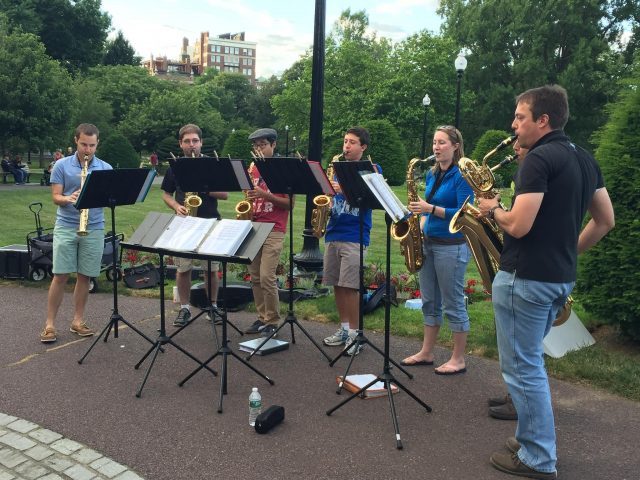Ethan R. Brush
Energy, Environmental, Transportation |
Market Co-Leader
Principal

I have been playing the saxophone since the age of 9 and it has remained a pretty serious hobby of mine ever since, perhaps only ever collecting dust for a time while attending engineering school. My job at Acentech gets me thinking a lot about sound and vibration and how they affect so many areas of our lives. The intersection of these topics is particularly interesting to me as an engineer and musician, and one I’d like to share.

My saxophone ensemble, The Saxyderms, playing on the Boston Common.
(I am on the far right.)
The saxophone is part of the woodwind family, which all use a column of vibrating air to produce the sound waves that we hear. A saxophonist must provide a very precise airflow pressure through the aperture between the reed and mouthpiece assembly so that the reed vibrates, creating an oscillating air flow. Not enough airflow pressure and the reed won’t vibrate and all you will hear is a hissing noise. Too much airflow and the back pressure forces the reed shut onto the mouthpiece, producing no sound. The frequency, or pitch, of the sound that we hear is a result of the natural frequency of the air in the saxophone body, which is essentially a conical pipe that is closed at the top (by the player’s mouth). The sound is a result of a standing wave, where reflections of the vibrating air inside the instrument add constructively.
Each note on the saxophone is created by opening and closing a series of tone holes that produce different natural frequencies of the oscillating air. The lowest note of the instrument is played by closing all of these tone holes. Interestingly, because of the way the pressure waves reflect inside the bore of the instrument to create a standing wave, the lowest note on a saxophone can produce a sound wavelength (wavelength = speed of sound / frequency) more than twice the length of the pipe. Opening of tone holes acts to raise the pitch of the sound, similar to making the pipe shorter. Register holes of a saxophone are controlled by the octave key of the player’s left thumb to also affect the pitch of a note. These holes disrupt the airflow in such a way that the frequency of the standing wave is doubled, thus raising the note keyed by the tone holes by one octave.
As any woodwind player knows, playing in tune and with good timbre is more than just blowing air and opening and closing keys. The way the reed vibrates to produce air oscillations changes with the applied airflow pressure and with the pressure applied by the mouth on and around the reed, also known as the embouchure. For any given note, the air pressure and embouchure can be varied to produce loud, quiet, bright, or mellow tones. The loudness or quietness is mainly a function of how hard the player blows. However, as the pressure on the reed increases due to airflow or embouchure its response is no longer purely sinusoidal and the resulting sound contains more than just the primary note frequency. These extra frequencies are called harmonics and are multiples of the lowest note frequency. A bright sound is rich in harmonics and is often preferred by jazz musicians. Mellow tones have less pronounced harmonics, and are often preferred by classical musicians for blending harmoniously with many other instruments. Therefore, precise breath and embouchure control are required to be able to play loud or soft and with a desired tone. Reed and mouthpiece selection also play a part in whether a player has a bright or mellow tone. In my experience, however, the embouchure is such an ingrained muscle memory that no matter what setup I’m playing on I still sound relatively the same. Players that want to change their “sound” to be more bright or mellow usually need to arduously re-teach their muscle memory on every note of the saxophone to get the right embouchure and breath control to match their desired tone.

Airflow Matters: These charts show how the combination of embouchure and breath control affect the vibrating airflow inside of the saxophone. Via UNSW
Some advanced playing techniques take advantage of the harmonics possible with saxophones, which are commonly referred to as overtones. Minute adjustments in embouchure and air stream, combined with alternate fingerings can isolate higher harmonics, which makes it possible for notes to be played that are higher than the standard tone and register holes will allow. These are known as altissimo notes and are famously used by saxophonist Lenny Pickett, the longtime musical director of the Saturday Night Live band.
Most musicians probably don’t ever consider the physics behind how their instruments work, nor do they necessarily need it to be successful. However, if you are curious like me there are much more in depth discussions online. In particular, the music acoustics department at the University of New South Whales in Sydney Australia has a popular website that covers the physics of many different musical instruments. You’ll see that I have barely scratched the surface on the topic of saxophone and woodwind acoustics.